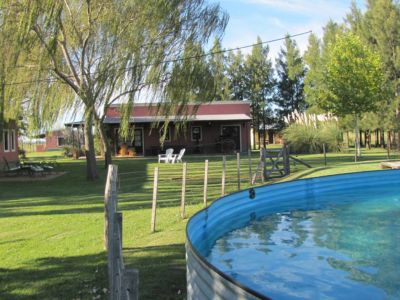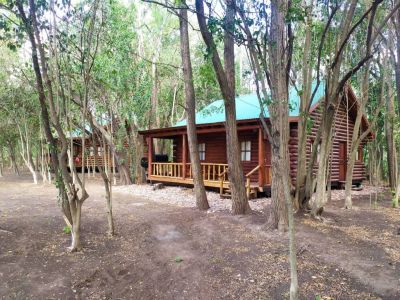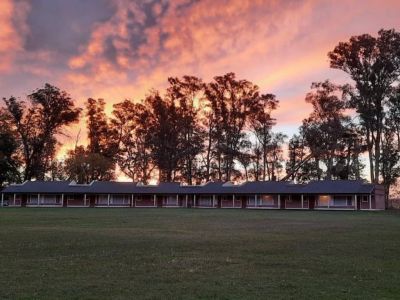As if by chance, shortly before visiting the museum, we were touring around parque Independencia (Independence Park). In addition to watching the famous suspended bridge over the river (a symbol of Mercedes), we could observe the banks of the Luján River after thousands of years of erosion caused by the changes in its volume.
But in spite of having watched the cliffs on both sides of the river, we would never have imagined what we would see in the Natural Science Museum.
Once inside the Museum
In 1947, a group of youngsters formed by José Fernando Bonaparte, Juan Arnaldo Pisano, Rodolfo Capaccio, Albor Ungaro, Aníbal Cueto, Italo Landi and Octimio Landi began to investigate novel disciplines for that time, Geology and Paleontology, following Florentino Ameghino’s steps, who had made some excavations in the basin of Luján River during the previous century. Directed by don Andrés Canessa, they had some fruitful field trips on the river banks of the Luján River and its tributaries.
In October, 1947, a major step for the history of the museum was taken: the Natural Science Museum was founded with the collection achieved during that year of research.
Although the material was not plenty, it was interesting. At the time of its foundation, the museum was called Carlos Ameghino Popular Museum of Natural Sciences, acknowledging the merit of the brother and collaborator of wise F. Ameghino, and it functioned temporarily in the ceremony room of the Casa del Pueblo (House of the People) of the Socialist Party.
Carlos Ameghino Natural Science Municipal Museum
Looking for Partners
In order for the museum to grow they looked for partners to achieve financial resources and conferences were usually held to increase the bond between the public and the museum.
Trips were made to other areas of the province displaying the material collected in the House of the People. In 1949, the first publication of the museum under the name Notes of Science and Cultural Disclosure took place. It was followed by others and they began to investigate another discipline: archeology.
The creation of the Municipal Museum of Natural Science was finally established in 1965 and the museum began to operate in Street 26 at 512 in a municipal building. The building was adapted to the needs of the museum. At present, it features display rooms, offices and a library.
The Most Diverse Rooms
The Municipal Museum of Natural Sciences Carlos Ameghino in the City of Mercedes is divided into several theme rooms.
In the room devoted to Paleontology there are fossils of extinct animal species that inhabited the region until the end of the Pleistocene Period. They were discovered during excavations carried out in Mercedes in fossil strata located on the banks of the Luján River. The importance of this discovery was recognized worldwide thanks to the research work carried out by Florentino Ameghino.
It is worth mentioning that many of these species, like the glyptodon, mastondon, megatherium and others, were in contact with the first human groups that inhabited the plains of Buenos Aires.
In the archeology rooms there are several displays devoted to the American settlement, including the main sites from Alaska to Tierra del Fuego with the corresponding dates. The cultural remains of hunter/gatherer groups that settled in the North of Buenos Aires until the time of the Spanish conquest can be seen there.
Lectures, Courses and Workshops
During the visit to the various rooms, not only did we have access to simple and based information, but our guides also managed to make us feel deeply interested in the subject.
Questions followed one another in almost every room as our eyes were amazed at so many fossils and animals that were perfectly reconstructed and looked just as if they were alive.
But there was a map of the Luján River and the various settlements on its shores that captivated us and earned the praises of most visitors. It displays the various excavations and animals found. Based on that map, man could determine what the ecosystem used to be in those years. Paleontologists and archeologists devoted hundreds of hours to dig up this real treasure.
Moreover, the museum also offers lectures, courses, audiovisual and slides presentations, guided visits and general information for tourists. The same includes workshops of fine art that run from April through December with displays, meetings, conferences, workshops and various activities related to the cultural life of the City of Mercedes.
* Part of the information was provided by the official site of the Municipality of the City of Mercedes: http://www.mercedes.gba.gov.ar (Natural Science Museum).
Pablo Etchevers
Pablo Etchevers
Contact of the excursion or tour
Natural Science Museum
Calle 26 Nº 512, Mercedes, Buenos Aires, Agentina
Phone: +54 2324-420511
















